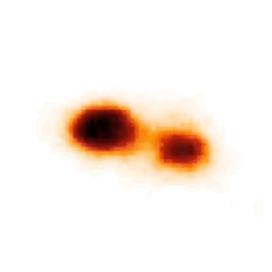File:Beta Lyrae - CHARA.gif
Beta_Lyrae_-_CHARA.gif (272 × 272 pixels, file size: 446 KB, MIME type: image/gif, looped, 48 frames, 9.6 s)
| This is a file from the Wikimedia Commons. Information from its description page there is shown below. Commons is a freely licensed media file repository. You can help. |
 This media file has been nominated for deletion since 29 March 2025. To discuss it, please visit the nomination page.
Do not remove this tag until the deletion nomination is closed. Reason for the nomination: I can find no evidence that this is under CC0 as claimed, nor under any free license. See archive of source page and current version of page. Another CHARA image was also claimed as CC0, so maybe this is stated somewhere that I'm missing?
| |||
Show further instructions
If this template was added because you clicked "Mark for deletion" in the left menu (right when using Vector 2022 skin), please make sure that all necessary pages have been created. If they haven't been created after a few minutes, or if you added this template manually, you should complete these steps:
{{subst:delete2|image=File:Beta Lyrae - CHARA.gif|reason=I can find no evidence that this is under CC0 as claimed, nor under any free license. See archive of source page and current version of page. Another CHARA image was also claimed as CC0, so maybe this is stated somewhere that I'm missing?}} ~~~~
For mass deletions: If you want to nominate several related images, please make a mass request by manually adding Note: This template is for requests that may require discussion in order to be deleted. For speedy deletions, you can use
| |||
Summary
| DescriptionBeta Lyrae - CHARA.gif |
English: Beta Lyrae is an interacting and eclipsing binary where material is gravitationally pulled away from one star and accretes on to the surface of the companion. The system has an orbital period of 13 days. Using the CHARA Array, researchers obtained images of beta Lyrae showing the mass donor and the thick disk surrounding the mass gainer. The donor is brighter and appears elongated; this is the first direct detection of photospheric tidal distortion due to Roche lobe filling. The disk component is fainter and more elongated than the donor.
Reference: Zhao et al. 2008, ApJ, 684, 95 |
| Date | |
| Source | http://chara.gsu.edu/astronomers/science-highlights/55-eclipsing-binaries |
| Author | Center for High Angular Resolution Astronomy |
Licensing
| This file is made available under the Creative Commons CC0 1.0 Universal Public Domain Dedication. | |
| The person who associated a work with this deed has dedicated the work to the public domain by waiving all of their rights to the work worldwide under copyright law, including all related and neighboring rights, to the extent allowed by law. You can copy, modify, distribute and perform the work, even for commercial purposes, all without asking permission.
http://creativecommons.org/publicdomain/zero/1.0/deed.enCC0Creative Commons Zero, Public Domain Dedicationfalsefalse |
Captions
Items portrayed in this file
depicts
21 August 2008
image/gif
f0a732e2901da14f1038062fd1d0e0ca8ef6a352
456,847 byte
9.599999999999998 second
272 pixel
272 pixel
File history
Click on a date/time to view the file as it appeared at that time.
| Date/Time | Thumbnail | Dimensions | User | Comment | |
|---|---|---|---|---|---|
| current | 17:34, 24 January 2020 |  | 272 × 272 (446 KB) | wikimediacommons>Meli thev | User created page with UploadWizard |
File usage
The following 3 pages use this file:

